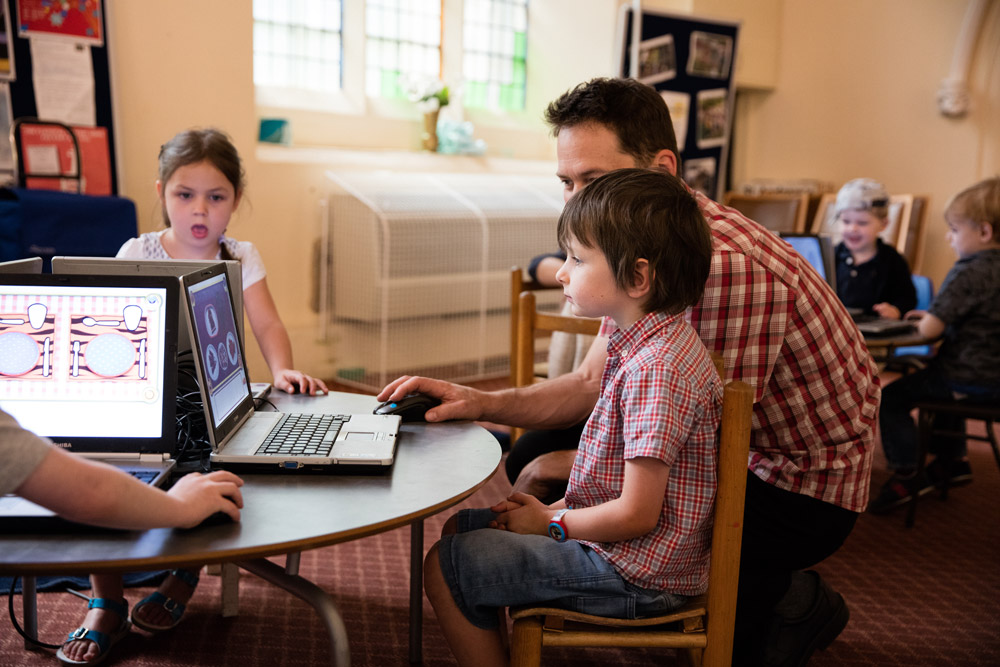Now more than ever, computers and technology used in schools is a topic of significant concern for students, caregivers, and educators alike. If you have never set foot in a Montessori school, you may be wondering how it compares to a mainstream school, especially in terms of digital technology use. With 20,000 Montessori schools operating independently worldwide (5,000 in the U.S. alone), it is hard to generalize these schools’ digital technology practices.
Most Montessori schools use computers and digital technology. However, technology use in a Montessori school looks very different than it does in a mainstream school. This is because the Montessori philosophy, also called the Montessori Method, has strict ideas about the classroom environment.
You might be wondering why any school in the 21st-century would want to opt for less digital technology instead of more. You may also have questions about the origins of Montessori and the “Method.” This article will help answer these questions.
How Do Montessori Schools Incorporate Technology?
Many, if not most Montessori educators embrace digital technology use with a caveat: it has to be meaningful. In other words, students should use digital technology to prepare themselves for the real world, rather than simply replacing real-world activities with high-tech ones. In the eyes of Montessori, simply making digital devices available to students is not enough; students must use these devices in meaningful ways.

Purposeful Technology Use in the Montessori Classroom
Purposeful, meaningful technology use sounds great, but how do you determine whether a student is using technology in a meaningful way? In Montessori education, one begins by asking: is this tool the best or only tool for this task? Consider an analogy: If you want to teach a student to nail a board, it is obviously better for them to use a hammer than a wrench or a screwdriver. If you want students to learn to use Google Slides, the best way to do that is to give them access to Google Slides.
When should digital technology not be used for student learning? According to Montessori thought, if there is another tool that will teach students the same skill as well or better than digital technology, then there is no reason to go digital. For example, using digital flashcards to practice math facts might be fun for the student, but it is not purposeful, since this activity could just as easily be done with real flashcards. This type of task does not teach the student anything new or useful about technology.
The analogies and examples above are fairly obvious, but what about the not-so obvious digital tools, such as so-called educational websites and ebooks? According to the American Academy of Pediatrics, one of the best ways for students to learn from digital sources is for an adult caregiver to watch with them and provide feedback. In other words, even the best websites and Montessori aligned apps cannot do the actual work of teaching. Since Montessori teachers confer with their students regularly and spend a lot of time observing their students at work, these practices should apply to digital technology in the classroom.
Students will probably never need to use digital flashcards in the real world, but they will need to learn to use programs like Google Slides. In Montessori, practicing and gaining real-world skills is called Practical Life exercises. Montessori educators who embrace digital technology often view it as a part of Practical Life.
Digital Technology and “Practical Life” Exercises
Practical Life exercises are an essential component of Montessori education. Dr. Montessori believed that humans move through life with meaning and purpose, and that children naturally want to do the same from an early age. For the youngest Montessori learners, Practical Life exercises might include activities such as:
- Tying shoelaces,
- Washing dishes
- Raking leaves.
Older students might learn sewing, woodworking, and caring for animals.
Dr. Montessori died long before the mainstream use of digital technology. Today’s Montessori educators have had to interpret what Practical Life exercises mean in today’s world. It stands to reason that today’s students will need greater technological expertise than previous generations. While gardening and learning to use hand tools are still part of a Montessori education, today’s list of Practical life exercises might include mastering Google Suite.

Digital Technology and Student Choice
If you were to walk into a Montessori classroom, you would probably see students working alone or in small groups on a variety of hands-on tasks. In a class of 25-30 students, only a few would be using digital technology at any given time. This is because both hands-on learning and student choice are key components of Montessori education.
Student choice is an essential component of Montessori education because of the many benefits it affords to students, both academically and behaviorally. Students who are taught to make responsible choices tend to be more motivated and take a great deal of pride in their competence. By practicing decision-making from an early age, students stand a better chance of growing into adults who can do the same.
How might student choice look in the context of digital technology in a Montessori classroom? It might look like giving students a choice of digital formats to use when working on an independent research topic, choosing the best app for plant identification, or using a mapping app to create an aerial view of a city. The possibilities for responsible student use and decision-making are many and varied.
Digital Technology in the Classroom Environment
When you enter a Montessori classroom, it’s impossible not to notice the beauty and variety of the room’s materials and the care with which things have been arranged for optimal student use. The prepared environment, an idea wherein the classroom is optimized for student learning and exploration, is a crucial piece of Montessori philosophy.
Montessori students are taught early on that they, not their teacher alone, are responsible for taking care of their classroom. Any digital technology in the classroom that is intended for student use (not teacher recordkeeping) is treated with the same attention as any other learning material. It also means that any computer-based activities are purposefully approved of and their use closely monitored by the teacher.

oes Montessori Use Technology
Over the years, many early childhood caregivers have expressed concern about the effects of screen time on child development. These conversations take place among Montessori educators as well. Dr. Montessori herself believed that young children learn best by using their hands to explore and manipulate concrete objects, which suggests that digital technology is inconsistent with educating young children. However, advances in connected technology, when an app on a tablet is connected to an object in the real world, challenges that thinking.
Generally speaking, as long as children are able to receive meaningful feedback, from both a digital activity and their caregiver, they will continue to grow as learners.
Montessori and Distance Learning
Of course, the COVID-19 virus changed the way we all live and the way we educate our children; Montessori is no exception. The closing of schools across the country has forced schools to adapt their learning plans to a digital format, sometimes with only a few weeks or less notice. This would seem at first glance to be a direct contradiction to Montessori philosophy.
However, Dr. Maria Montessori believed that education should be preparation for life. Although the world has changed drastically in the past few months and years, all educators and caregivers are called upon to prepare students as best they can. In these times, “Practical Life” exercises might include making a homemade mask or doing chores. Either way, learning opportunities surround us, and we are all receiving a one-of-a-kind education.


